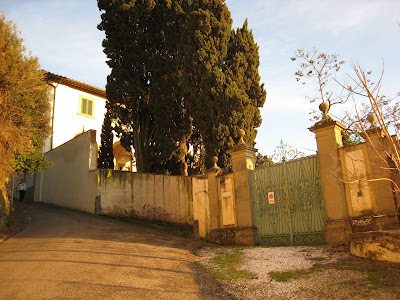The bus line that brought the boys to school arbitrarily stopped Monday so they climbed up to school the back way up a winding series of steps from the Porta San Niccolo. We found another way with two bus lines and they are back in business and, most importantly, learning lessons about self-reliance. When the bus lines changed, Evan was coming home earlier than Ryan and ended up way out in Florence somewhere on a different bus. So, he called a taxi! The school is a little over two miles away--very close to Piazzale Michelangelo (which is on a hill overlooking the city) in a Renaissance villa and it still has its formal gardens (certainly not in the shape they once were!), beautiful views of the city and the surrounding Tuscan hills. Ryan found out this week that his class will be making a trip to St. Petersburg, Russia for a week in March. They will be at a model United Nations meeting with kids from all over and then they’ll also get to tour around for several days. So, Ryan from Texas will take a trip to Russia with his classmates from Italy to represent Korea!
This week I started Elaine Ruffalo’s Art History Course in Florence which is intended as an intro to the art and architecture of the Italian Renaissance, with a special emphasis on Florence---each week devoted to a single topic or decorative complex. Part of why I wanted to do this course was to learn why Florence figured so importantly in the Renaissance. She told us that the original wealth in Florence came from the Wool Guild. The Italians developed the dying process—discovering that alum bound pigment to fabric. This, mixed with the fast flowing Arno River for washing fabrics, was a great combo. The famous Florentine purples and reds, respectively, come from sea urchin ink and crushed ladybug shells!! The business and money from the wool making business in turn helped develop the silk business, apothecaries, linen and shoemaker guilds, and ultimately, the banking guilds. The arts then followed the money in Florence. It has been hard to comprehend how all of this happened in one place. We did get to Orsan Michele, which is the old granary turned into a church…you got it, first there was a church there that was torn down and a granary built on the site and then there was a sighting of the Virgin Mary on one of the columns in the open grain trading area, and they built an altar over the area, closed it in and made it a church!! The church still has openings in the columns for the chutes that sent grain down from the upstairs grain storage area! On the outside of church are the statues of patron saints for the various guilds (kind of a "grain and god" type of place!)
We are staying close to a street named Corso dei Tintori, the original area where the wool dyers (tintori) lived. This is such an old section that closeby, one of the curved streets is shaped that way because it was one side of the original Roman amphitheater. I still find it easy to get lost…the streets wind around and since this has the medieval layout, the buildings were crammed inside the city walls with narrow streets, and you never really get a look at the horizon to see exactly where you are. In fact, after the bubonic plague in the 1300s, they actually moved the second set of Roman walls inside the original ones because so much of the population was wiped out. Some days you’ll find a store or place on a street, but then the next day it may be locked up with a metal grate or huge wooden doors and you think you’re going crazy because you could have sworn you saw it on this same street and now it seems to have evaporated. There are some other wild streets here: Borgo Allegri (street of the happy or joyful ones) and Via del Malcontenti (street of the unhappy ones...especially as those who walked down this street were on their way to the gallows!). I prefer to walk down Borgo Allegri if at all possible.
It is not high tourist time right now and you can get into the museums and sights without lines or throngs of people. The restaurants are mostly filled with Italians but many restaurants close down in January because it is so slow and repairs are made, people take vacations and it is cold. There is a feeling of displacement being here, not speaking the language, really being an observer and, almost invisible. I like the early mornings when the vendors on Via dei Greci are setting up their carts of scarves and gloves and knick knacks and the news vendors are opening their stands and the Florentine women in high heels are walking their little coiffed, sweatered lap dogs over the cobblestones. I went into Saint Niccolo church the other day early to take a look and watched as several of the vendors came in to say a little prayer to the Virgin Mary before going about their day.
 |
| altar at Orsan Michele church in right front corner right over the spot where the sighting of Mary was! |
 |
| one of many Medici villas outside Florence |
 |
| Fred, Ryan and Evan on via Pepi |

